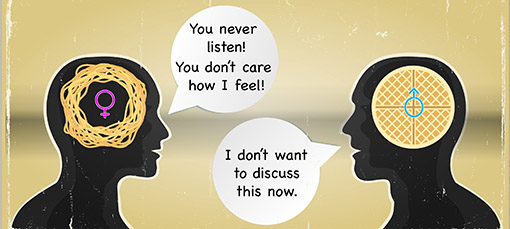By Jill Long
The way men and women communicate differently is a topic discussed by almost everyone. Issues arise in relationships as a result of these communication differences, and ongoing issues in communication can lead to broken relationships. Creating a dynamic of effective communication can promote our relationships. Practicing effective communication by using active listening skills can help. The purpose of active communication is to understand or be understood. Active listening is not designed to determine if someone is right or wrong, but to improve our relationships, create a less stressful life, and promote a more harmonious environment.
Based on our unique environments, no two people communicate in the same way. We do tend to respond more positively to others who have similar backgrounds and beliefs, and tend to have a more difficult time communicating effectively or being understood by people who have different values and beliefs. Also, no two people’s brains are wired the same which also facilitates different perspectives and therefore different communication styles. This seems to present itself between men and women.
Different communication styles between men and women can be frustrating. Women’s style has been compared to spaghetti. Everything runs together and it is hard to not connect things, which may be why we tend to bring up past wrongdoings during an argument. Men’s communication style has been compared to waffles. Pockets of information that do not necessarily interconnect. Men tend to be problem-solvers and want to suggest solutions to situations. They tend to focus on the immediate issue, whereas, women tend to communicate for connection, but intermingle thoughts together. Many times, women just want to be understood and empathized with, not given solutions. Therefore, women and men can have problems communicating.
These differences can create problems with our spouse/significant other because we live and create a life with them. If there are too many disagreements or differences in lifestyle choices and the way communication about these occur, relationships can become estranged. If ineffective communication has not changed, and there is no resolution or repair, relationships can dissolve.
As was mentioned earlier, women’s thoughts are entangled together (like spaghetti) and we tend to connect thoughts and communicate accordingly. When this happens, the man can become overwhelmed and shut down. This is known as stonewalling. He may go to another room and can become basically non-communicative. This behavior may trigger women to talk more and get more aggravated as she feels he doesn’t care. The argument may escalate because the woman doesn’t feel heard and the man feels overwhelmed. The man again, is a problem solver, and may need time to process all that is being said, but because of the differences in communication style, the argument has taken on its’ own life and may no longer be about what it started as. Women may need an outlet to vent their frustrations and men may need time to “cave” and process.
In addition to being aware of these differences, both parties can benefit by participating in active listening with each other. Active listening is as the name implies, “active.” Active listening uses open ended questions, reflective statements, and clarification. Open ended questions are questions designed to continue the communication, not questions that allow for a yes, no, or one-word answer. An everyday example of open-ended question would be, “Tell me about your day,” opposed to a close-ended question such as “How was work/school today?” The first statement would require more conversation than the second. The second could be answered with “fine,” or “awful.” Open ended questions solicit more conversation than closed questions. The second part of active listening is reflective statements. This is not just parroting what someone says, but reflecting the content as well as the feeling. Reflective statements require a certain amount of empathy and are a big connection point for women. They can also cut down on defensiveness because you are not thinking about yourself or your next comment. It further helps to calm the other person as they feel understood. Finally, active listening uses clarification to make sure you thoroughly understand where the other person is coming from. You can reflect back what you have heard and say “Let me see if I understand what you are saying.”
As I said, reflective listening is a connection point for women. The term “empathy” comes to mind when thinking about active/reflective listening. Empathy is having an emotional or intellectual connection with another person. It is taking time to “walk in someone else’s shoes,” to live their life for just a few minutes. Try using empathy the next time you are in a conversation with someone. Reflect their feelings and their situations back to them and see how it goes. You’re not agreeing with what they are saying or implying that they are right or wrong, you are just identifying how they feel and reflecting back what you have heard.
Obviously effective communication is very hard work. Effective communication requires us to be able to let our guard down, become vulnerable at times, and not believe that every discussion requires someone to be right and someone else to be wrong. The object of effective communication and therefore improved relationships is to be able to live in harmony whether we are spaghetti or waffles. Active listening is a big part of effective communication and can improve relationships.
Whether you are spaghetti or waffles, awareness of differences and communicating using active listening can create a more peaceful style of communication. Active listening cuts down on the need to be right, defensiveness, and feelings of disconnection. Our lives and our relationships can be so much less stressful if we seek to understand others. We are also much more likely to come up with solutions or compromises if we understand the other perspective.
Practicing active listening can improve our relationships and help us in our everyday relationships at home as well as in our work life.

